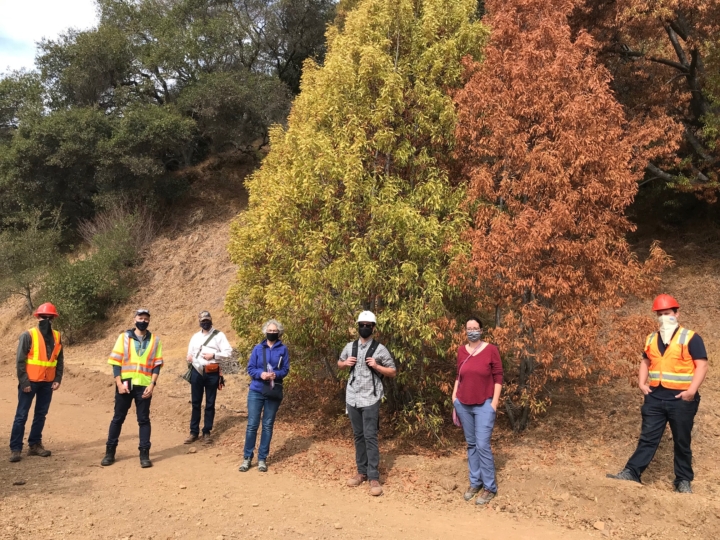
A broad pattern of tree deaths across the East Bay Regional Park District has raised alarms for the park’s fire risk management team as the Bay Area enters an extreme drought and a high-risk fire season.
Around 1,000 acres of trees, from invasive eucalyptus and acacias to native pines and bay laurels, are dead or dying, according to the park district. That includes around 62 acres in Tilden, which is 2,079 acres total, and 624 acres in Anthony Chabot, which is 5,067. EBRPD totals 124,909 acres.
“It’s bigger than the park district. It’s really a regional issue” affecting woodland throughout Alameda and Contra Costa counties and starting to affect areas in Marin and San Mateo counties, said Aileen Theile, EBRPD’s fire chief. And as a dry summer approaches, she added, “it’s quickly going to become a public safety issue.”
Park staff noticed the tree death and die-back in October 2020 while doing standard fire reduction and vegetation care in various areas of the parks. The increase in dead wood is “right in the middle of the wildland-urban interface,” which is particularly worrying for fire management, Theile said.

After noticing the tree damage last fall, EBRPD surveyed the parks from a helicopter to estimate its extent. It’s easy for visitors to the parks to spot the die-back: “All they really have to do is look up and east,” Theile said.
Crews have been hard at work everywhere from along Grizzly Peak Boulevard to the Brazil Building and Reinhardt Redwood Regional Park, removing low-hanging dead branches, clearing dead foliage and checking in with the Bay Area Air Quality Management District to burn the detritus quickly while conditions allow. In mid-May, there will also be a small prescribed burn in Tilden of an area that the park district has been monitoring and maintaining for years, Theile said.
“It’s obviously a dynamic and evolving situation, and we have a lot more to learn [but] doing nothing is not an option,” Theile said.

The wide variety of species that are struggling or dying, plus recent weather conditions and the geographic distribution of the die-backs, point to drought stress as a root cause, according to Natalie van Doorn, a research urban ecologist, and Susan Frankel, a plant pathologist, both at the US Forest Service’s Pacific Southwest Research Station in Albany. The stress of drought makes trees more susceptible to pathogens and parasites, such as two fungi that researchers have seen damaging many of the acacia in the recent die-off, van Doorn and Frankel said via email.
Since “problems of this type do not respect property boundaries, and resources are scarce,” multiple local, regional, state and federal organizations are working together to untangle this problem, van Doorn and Frankel said, including the USDA Forest Service, the UC Berkeley Forest Pathology and Mycology Lab, Cal Fire and EBRPD. Even small organizations like the Friends of Sausal Creek and Friends of Joaquin Miller Park are helping raise awareness and reporting patches of dead trees, they added.
Drought has caused problems for forests in California before. From 2012 to 2015, a severe drought in the Sierra Nevada killed 140 million trees, mostly conifers, van Doorn and Frankel said. Climate change-fueled heat waves magnified the impact of that drought and others across the state, according to climate researchers. However, the die-back noticed last fall is the first time researchers have seen a pattern of mortality and die-back in the Bay Area, the pair wrote.

Some people use the terms “die-back” and “die-off” interchangeably, but distinguishing between trees that appear dead versus trees that are actually dead is surprisingly difficult, and the term “die-back” acknowledges that some of the trees may recover, van Doorn and Frankel said. Eucalyptus and acacia in particular are known to vigorously re-sprout after damage.
“The extent and severity of the die-back and die-off of trees in the Bay Area has not been fully documented yet, so it is difficult to compare to other die-off events. It may be that some of the trees recover, since the roots may not be dead,” van Doorn and Frankel wrote.
EBRPD’s work to manage the die-back shouldn’t affect visitors to Tilden or the district’s other parks unless high wind or other heightened fire danger events force the district to close a park, Theile said. And though the park may be closed, staff are still working to protect the land and the people living nearby.
This story was updated at 12:15 p.m. on May 4 to include a map of areas affected by the die-back, a list of acres impacted by park and more information from an EBRPD committee meeting.
